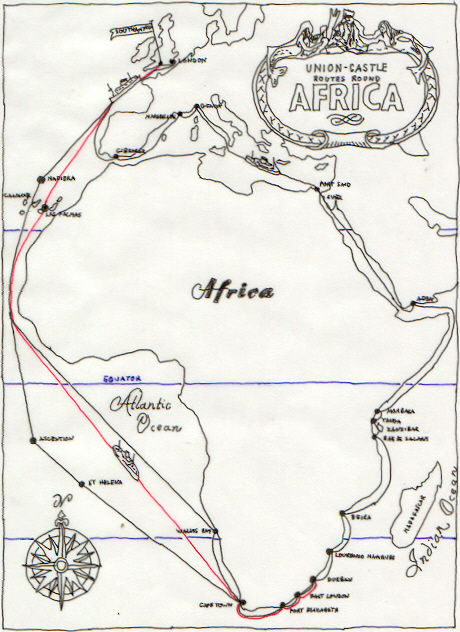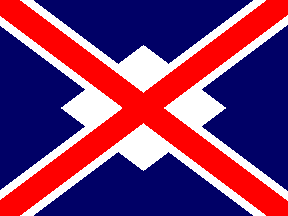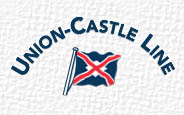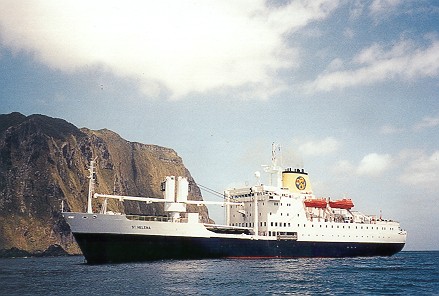|
History |
|
|
| RETURN TO THE HOMEPAGE
RMS WINDSOR CASTLE 1960
|
|
Construction and Launch (1956 - 1960): Above: The House Flag of Cammell Laird & Co. Ltd. In 1956 the Union-Castle Line was taken over by the
Cayzer Family and became part of the British & Commonwealth
Shipping Group with the Cayzer Family's Clan Line. Soon exciting plans
for the future of Union-Castle Line's passenger service were announced.
It was revealed that negotiations were underway with Harland &
Wolff, Belfast to alter, improve and enlarge the RMS Pendennis Castle,
the new mailship ordered in 1955 by the then chairman, Sir George
Christopher. Orders for new mailships had already been announced and it
was then revealed that Union-Castle Line were planning to reduce the
voyage time between Southampton and Cape Town to 11.5 days and that
only 7 ships (compared to the then 8 in operation) would be required to
operate the accelerated service. In August 1956 further details were
released of the improvements to the RMS Pendennis Castle, but also of
the first of the new mailships - a new superliner. She was to be the
biggest and best liner ever to enter service on the South African
service - a new 38,000 tonnes Windsor Castle (reviving an old
Union-Castle name) - to be built at Cammell Laird, Birkenhead. This
represented a considerable break with tradition as the Union-Castle
mailships had been built at Harland & Wolff, Belfast since 1900. Two weeks into 1959, with the RMS Pendennis Castle being
feted at the Cape on arrival there on her maiden voyage, the
announcement was made to the world that the RMS Windsor Castle was to
be named an launched on the 23rd June 1959 by Her Majesty Queen
Elizabeth the Queen Mother. Not only was this the largest passenger
liner ever built on Merseyside, but she was the largest to be launched
at a British shipyard since Cunard Line's RMS Queen Elizabeth in1938.
She was to cost over Ł10 million and was scheduled to make her maiden
voyage in August 1960. "In this new ship we
have tried to cater for the comfort and amusement of our passeners, to
provide a ship that is colourful and pleasing to the eye and gives a
sense of rest and respose." The RMS WINDSOR CASTLE was launched June 23, 1959 by HM Queen Elizabeth, the Queen Mother, in a greatly publicized ceremony. All this aroused considerable interest, but particularly exciting was BBC Television's decision to cover the launch live, the first time the naming and launching of a great liner had received such coverage. Wynford Vaughan-Thomas was named as the commentator for the event. On Tuesday 23rd June 1959 the day of the launch arrived. The launch party and media travelled on the 07:45 special train from London Euston to Liverpool Lime Street. They arrived at 11:30 at Liverpool and were taken by coaches over to the shipyard in Birkenhead where the launch party and media were on the launch platform by 12:45 for the launch ceremony. The Queen Mother was scheduled to name and launch the vessel at 13:30. Unfortunately at 13:25 she had a severe nosebleed which threatened to delay the event, but the calm Queen Mother took control and carried out the christening only one minute past its scheduled time of 1:30 pm. A great roar of applause greeted her as she came on to the launch platform, from where she successfully carried out the launching ceremony in magnificent style. "I name this ship Windsor Castle. May God bless her and all who sail in her." Words of Her Majesty Queen
Elizabeth the Queen Mother at the Launch Ceremony, 23rd June 1959. By 13:45 the launch party and media had left the
launching platform. The Queen Mother left the shipyard at 15:30 and 10
minutes later, the launch party left by coach for afternoon tea at the
Adelphi Hotel in Liverpool.The launch party and media then returned to
London on the 17:15 train from Liverpool Lime Street. During the
journey a bizarre incident occured. Some idiot fired an air rifle at
the train as it sped through the countryside and the pellet drilled a
neat hole in the carriage window about 12 inches above the head of
Nicola Cayzer, daughter of the UCL chairman. One of the leading
journalists commented: "This will
guarantee the launch story is on every front page!" Sure enough
the story did make most of the front pages of the national newspapers! At the time of the ship's launch, she was the largest
liner
built in England, the largest liner owned by Union-Castle and the first
Union-Castle liner constructed at the Cammell Laird Shipyard,
Birkenhead on the River Mersey. A not so well known fact was that the
electro-hydraulic
steering gear on board her was installed by Brown Bros. & Co. Ltd.
Also the engines, and
propulsion systems and steering gear onboard the RMS Windsor Castle
were Navy
standard, and held a secret high horsepower rating so she could be used
as a ultra fast
troopship, in the event of war. Before the launch of the Windsor Castle
the previous largest liner built on the Mersey had been Cunard Line's
second Mauretania launched in 1938. Unfortunately the Windsor Castle's
status as the largest liner built in England only lasted a few months
as on the 3rd Nov. 1959 the Oriana was launched at Barrow in Furness
for the Orient Steam Navigation Company. Both liners entered service
for their respective shipping companies in 1960, Windsor Castle had her
maiden voyage on the 18th August 1960 and the Oriana had hers on the
3rd December 1960, both sailing from Southampton. In 1960 after her launch and
fitting out lavish plans were made for the Windsor Castle to make a
major 5 day shakedown cruise from Liverpool on her
shakedown voyage to Southampton via Edinburgh and Rotterdam. It was
planned that she would depart Liverpool on the 14th
July 1960 eventually arriving in Southampton on the 19th July 1960.
This was inspired by the recent success of a similar shakedown cruise
undertaken by the Pendennis Castle in 1958. However due to a seaman's
dispute the Windsor Castle's shakedown voyage had to be cancelled at
the last minute and the ship arrived in Southampton two days earlier
than planned. The Deputy Chairman, Anthony Cayzer, who had been in
charge of the overall arrangements for what would have been a memorable
voyage aboard the mailship, was furious. Maiden Voyage and the Union-Castle Years (1960 - 1977): To compensate to some extent for the disappointment
following the last minute cancellation of the major shakedown cruise,
arrangements were made for a right royal send off for Union-Castle's
new flagship Windsor Castle on the 18th August 1960. Once again,
however, a threatened strike disrupted the elaborate preparations and
the ship sailed from Southampton at 15:00, a full hour before her
scheduled time. Despite this inauspicious start, Windsor Castle, which
was the largest vessel to ever make the Cape run regularly, proved a
most popular ship, and during her 17 years in service completed 124
round voyages to South Africa, carrying 270,000 passengers over
1,662,000 miles. In 1960 she entered service replacing the Winchester Castle of 1930. Her maiden voyage from Southampton to Durban via Las Palmas, Cape Town, Port Elizabeth and East London began on August 18, 1960, and was completed in a mere 11.5 days. At the time the RMS Windsor Castle, along with the Leonardo da Vinci (Italian Line) and S/S Oriana (Orient Line), was regarded as one of the three most outstanding new passenger ships of 1960. In an article later in 1960 the noted British liner critic, C.M. Squarey, described how modern communication and travel had narrowed the differences between various services to a single common denominator of high international standard as follows: "For instance suppose that the Oriana were put on the Southampton to New York run, the RMS Windsor Castle on the Australian service and Leonardo da Vinci on the African route, is it likely that they would be accepted by the regular passengers on those trades as having the required amenities and in general find favour outside their normal sphere of operation? ... All of them are air conditioned so that trading in tropical waters presents no difficulties. In my view their public rooms and their cabins are perfectly acceptable for any trade." C.M. Squarey (the noted British liner critic) During her second voyage, the WINDSOR CASTLE rendered assistance to the crew of dowager fleetmate, CAPETOWN CASTLE, following an engine room explosion at Las Palmas. With the sailing of Windsor Castle on 16th July 1965 the mail service was accelerated to provide a Southampton to Cape Town passage of 11 days. The familiar 4 pm Thursday departure gave way to a 1 pm Friday departure which became the final pattern of sailings that was to last for 12 more years. The final cycle of weekly sailings saw the Mailships depart Southampton in the following order - an order which remained unchanged until their ultimate withdrawal: Windsor Castle In May 1967 the RMS Windsor Castle was involved in a dramatic race from Cape Town to Southampton against a motor car. It began after Union-Castle Line claimed sea travel was the fastest means of travel from South Africa after air. The Ford Motor Company disputed this and threw down the gauntlet for the ship to race one of their cars from Cape Town back to England. So the RMS Windsor Castle took up the challenge and in May 1967 raced home against a Halewood built Ford Corsair 2000E in a dramatic and nail biting race between these two Merseyside built machines. Sadly despite the high profile nature of this race sadly press coverage was muted. The ship and the car (with rally drivers Ken Chambers and Eric Chapman), left simultaneously from Cape Town dockside to a great send off bound for Southampton. The liner’s 7,000 mile sea voyage was pitched against the 9,700 road journey. Chambers and Chapman had many adventures along the way. Including a moment when the Corsair fell into a 6ft, water filled pothole and had to be rescued by 30 locals and 200ft of rope. Other challenges included petrol shortages (nuns once gave them beer as a substitute!), armed Congolese soldiers forcing frequent stops (their support team and plane were locked up for several days), plus 24 tyre changes and 37 puncture repairs. Even, just before reaching Southampton, they were pulled over by West Sussex Police and cautioned for having a dirty number plate! Accounting for the driver’s air travel, the race was declared a draw, although the Corsair arrived the evening before the ship sailed in. So another dramatic episode in the life of the RMS Windsor Castle came to an end, but many more adventures beckoned. In December 1967 she celebrated her 50th voyage, which
was celebrated in great style, having steamed 700,000 miles and carried
35,000 passengers with no breakdowns or delays. She
underwent refits in 1967 and 1972, which altered her tonnage to 36,123
and 36,277, respectively and continued sailing reliably on the famous
Cape Mail service. The great vessel was the flagship of the Union Castle fleet, but sadly her career was shortlived. By the 1970s, with the advent of the jumbo jet and economy air travel to South Africa and all parts of the world, Union Castle began to phase out its money-losing passenger services. In June 1974 Windsor Castle completed her 100th voyage
between Southampton and Cape Town. She had by then sailed 1.4 million
miles without missing one scheduled sailing. In November 1976 one voyage had a quite dramatic incident. An early morning stroll to enjoy the warm South Atlantic breezes from the RMS Windsor Castle turned into a terrifying ordeal for 64 year old Margaret Fuller. At the time the ship was some 250 miles off the Angolan coast, in shark infested waters and 1,400 miles from Cape Town, her next port of call. Mrs Fuller’s husband, Leslie, alerted the crew at 9am. After a brief search, at 9.11am it was assumed that Mrs Fuller might have fallen overboard. Captain Patrick Beadon, executed an emergency U-turn and retraced his course. He asked the crew and passengers to line the rails of the ship as lookouts. Superb seamanship, accounting for the ocean swell and wind direction, returned the RMS Windsor Castle to where Mrs Fuller was still treading water after three hours. With the ship hove to just 50 yards from Mrs Fuller a lifeboat was launched. Her rescue became a dramatic race against time as onlookers claimed that they had seen a shark circling around her. Praising Mrs Fuller’s fortitude, Captain Beadon said that, although she was fit and a good swimmer, many people drown after the psychological shock of seeing the ship disappear over the horizon. Unsurprisingly Mrs Fuller completed the voyage to South Africa under sedation in the ship’s hospital, suffering from bruising and hypothermia. Her eventual fate is unrecorded, but Mrs Fuller, from Hampshire, was emigrating to South Africa and her son, who lived in Botswana planned to meet his parents in Port Elizabeth. In early 1977 it was announced that both Windsor Castle
and S.A. Vaal would be withdrawn from service later that year. The
Windsor Castle's final voyage was scheduled for Friday 12th August
1977. A special luncheon, arranged and hosted by Sir Nicholas Cayzer,
was held on board on Wednesday 10th August 1977. In his speech
welcoming guests, Sir Nicholas said that he saw this moment as the end
of an era more relaxed and enjoyable than today and a more gracious age
to live in. Departure, two days later, was delayed for an hour owing
to a signal failure causing the late arrival at Southampton Docks of
the Union-Castle Express boat train from London Waterloo. Windsor
Castle eventually sailed on her last voyage to Cape Town at 14:00
carrying some 800 passengers, cargo and mail. Despite the delay, this
final sailing for Union-Castle was attended with great ceremony,
including a RAF flypast - a rare distinction indeed. Above: Map of Union-Castle Line ocean liner routes from UK to South Africa, the RED line being the express mailship route used by the RMS Windsor Castle. Southampton - Cape Town, Port Elizabeth, East London and Durban. (Map by Alex Naughton) John S. Latsis Years (1977 - 1990): She was bought by John S. Latsis (Santa Margarita Shipping & Trading Co.), the Greek oil and shipping tycoon, and sailed from Southampton on October 3, 1977 for Greece with a Greek crew, yellow funnel and her port anchor (not properly raised) crashing against her hull plating. Renamed MARGARITA L (after one of Latsis' two daughters), her new livery called for an all-white hull and a buff funnel in lieu of UCL's colours of lavender and red, respectively. On the first night at sea, one of the Greek crewmen switched off an oil pump, seizing one of the turbines. Union-Castle engineers had to work day and night fitting new bearings to get her operational again. Thus she became the flagship of Latsis's shipping fleet. A little known fact is that the other bidders for the ship at the time were Sitmar Line and Carnival Cruise Lines as at the time she was seen as a very popular and viable ship for adaptation as a full time cruise ship. So if things had turned out differently and she was not acquired by John S. Latsis she may have become a popular cruise ship in either the Sitmar Line or Carnival Cruise Lines fleets, perhaps even joining her former fleetmate, the former Transvaal Castle with Carnival. MARGARITA L was converted at Piraeus for use as an 852 berth luxury accommodation ship. Then after a year laid up at Eleusis, the former Windsor Castle set sail for Jeddah, Saudi Arabia (port city for Mecca). She was berthed in the Jeddah docks, where Latsis was building a navy base for Saudi Arabia. Escalators were installed on the quayside and a helicopter landing pad was fitted on her aft deck near the former first class Promenade Deck pool area. The forward hold was fitted with a desalinisation unit producing 600 tonnes of fresh water a day. The former Windsor Castle stayed at Jeddah from 1978 to 1990. During this period she moved twice, first a little farther up the coast to where Latsis was building a palace for the future King Fahd of Saudi Arabia. Here in Feb 1979 she replaced MARIANNA VI (ex-AUREOL) at a special jetty two miles north of Jeddah as the centre of a complex with car parks, swimming pools and sports facilities. Her second move was to Rabegh, where Latsis was building an oil refinery. Here she was used as an office and leisure centre for Latsis-owned Petrola Int. S.A. Construction Company. She was dry docked at five year intervals, first in Piraeus and then in Bahrain. The Twilight Years: Laid up in Greece (1990 - 2004): After 1990 her usefulness at an end, the former Windsor Castle returned to Eleusis, Greece to be laid up and occasionally used as private quarters by Mr. Latsis during his visits to Greece. With Mr. Latsis in declining health, the MARGARITA L and three other former British built passenger vessels in his fleet were offered for sale in 1998. The remarkably well-preserved ship has recently had its boilers retubed, although a turbine is in need of repair. Peter Knego, a classic ship expert who managed to get on board the former Windsor Castle in 1998, says that her interiors are much as they were 30 years ago. He says: "She still has the same chairs, brass railings, linoleum decking, chandeliers, even most of the same carpeting and soft furnishing. Signs in the passageways still say Windsor Castle, especially in officers' territory. She is a treasure trove of classic fittings and would make a magnificent museum or hotel. I think Latsis's people are holding out for this, as her asking price is still above scrap value." "Sadly, it would be a poor investment to restore her to cruise service as 2010 would force her retirement. One would have to recoup the moneys spent on a refit in too short a time to make sailing her again viable. Her engines need work and crewing a steamship is very difficult nowadays. Add to that the price of fuel and the lack of interest in other steamships that are in better condition and cannot find work and it looks more and more as if she will be going to the scrappers." Then she was owned by the Santa Marianna Shipping & Trading Corp. (Latsis Group) Piraeus. Her asking price in 1998 was around Ł5-6 million. The signs are not encouraging. Two other Latsis owned liners nearby, the former Aureol and the Principe Perfeito (moored alongside the former Windsor Castle) were scrapped in mid 2002. It is sad to think that the Windsor Castle was threatened with scrapping therefore taking with her an irreplaceable slice of Britain's proud shipbuilding heritage. However in 2002 / 2003 her asking price has been lowered to around Ł2.5 million and her scrap value is estimated at just under Ł2 million. In 2002 Alex Naughton was inspired by the Maritime
Matters website and suggested the idea of possibly attempting to
preserve her for Britain at a UK port. As a result of that the RMS
Windsor Castle project was founded by him as an unincorporated society
and a campaign website was set up to attempt to save the liner for
Britain. Despite rumours in May 2003 that the ship had been sold to Indian scrap merchants, the ship was at that stage still intact and in Greece owned by the Latsis Group, but clearly still slowly deteriorating. In April 2003 the Latsis family announced the death of John S. Latsis the founder of the Latsis Group and the former owner of the Windsor Castle, which has been passed on to his son Spyro Latsis. On the 12th February 2004 the former Windsor Castle broke
her left chain and lost her anchor during a snowstorm that hit the
Athens area and as a result she
went adrift without crew or passengers and went aground in shallow
water off Salamis Island. Fortunately the ship was undamaged and was
refloated on the 19th February 2004 and returned to her usual mooring
in Eleusis Bay. This information came to the Trust from Captain George
Graikos who is based in Piraeus. Sadly in
December 2004, with
scrap prices soaring, it was confirmed that the Margarita L (formerly
known as
the On the 11th
May
2005 she arrived off the Indian coast at the It is remarkable to note that the former RMS Windsor Castle accomplished her final voyage under her own steam (at least for most of the voyage) and with great dignity and elegance, thus showing that her old engines are still working and very reliable despite over 10 years laid up. So she was reliable to the last. This is a fine tribute to her builders – Cammell Laird Birkenhead, and their world class workmanship and engineering excellence. However her last voyage as we mentioned above was not entirely without incident as she seemed reluctant to be scrapped and made every effort to evade the scrappers, a truly special ship right to the end with real character. Trinity
Marine (www.trinitymarine.co.uk)
nautical
antiques and marine collectables based in Teignmouth in One of the
unusual items salvaged by Trinity Marine is one of the huge ship's
horns from the RMS Windsor Castle! They were 1500kg Swedish "Super
Tyfons" made by Kocknums Mekaniska Verkstad, Malmo, Sweden.
The
silverware manufacturers Mappin & Webb Ltd and Elkington & Co.
are both now part of British Silverware Ltd (www.britishsilverware.co.uk)
although Mappin & Webb Ltd continues as a subsidiary brand (www.mappin-and-webb.co.uk).
While the pottery and china manufacturers G.L. Ashworth & Bros Ltd,
Mason's Ironstone, and Dunn Bennett & Co. Ltd all are now part of
the
Waterford Wedgwood Group (www.waterfordwedgwood.com)
and no longer continue as distinct brands apart from Mason's Ironstone.
Another
website where items of furniture and other artefacts from the former
RMS Windsor Castle are available for sale is Peter Knego's
MidshipCentury website (www.midshipcentury.com). The
best way to find them from the home page is to go to the ship index and
search for Margarita L or RMS Windsor Castle. These items were acquired
by Peter Knego in Alang, India when the ship was being scrapped in
2005. We would encourage those interested to have a look at this
wonderful website and why not buy a few items if you wish! We now
honour and pay our
special and heartfelt tribute to all the wonderful men and women of
Cammell
Laird and the suppliers around Merseyside, the Finally we
now pay our
tribute to the ship herself – the Farewell
our noble friend,
may you rest in peace, and long may your legacy endure so that people
continue
to honour and remember the great ocean greyhounds such as yourself from
the
Golden Age of Ocean Travel. Click below to read some Union-Castle descriptions of the RMS Windsor Castle and its interiors: RMS Windsor Castle - A Description by Union-Castle Line 1960 For more information on the history of Union-Castle Line see the following website: www.union-castle-line.com (Union-Castle Line historical website) For information about travelling on the RMS St Helena which currently sails from Portland in Dorset, UK to Cape Town (South Africa) on a route similar to the Union-Castle Line ships via Tenerife, Ascension Island and St Helena please see the following website: www.rms-st-helena.com (RMS St Helena website) managed by Andrew Weir Shipping Ltd (www.aws.co.uk) |
|
(c) Cruise Ship History Collection 2018 including www.thecunarders.co.uk A Edward Elliott |






